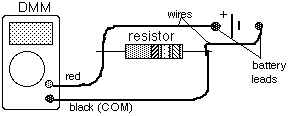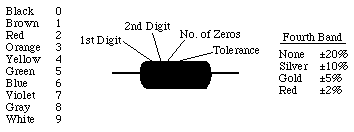OHM'S LAW LAB
Gunn Physics
PURPOSE:
The purpose of this lab is to investigate the relationship between
the three variables involved in Ohm's Law - Current, Voltage and
Resistance.
MATERIALS:
- Circuits Experiment Board
- D-Cell
- Wire
- Digital Multimeter (DMM)
- Resistors
PROCEDURE:
- Choose one of the resistors that you have been given. Using
the chart at the bottom of this page or your notes, decode the resistance
value and record that value in the first column of the Data Table.

- Construct the circuit above, leaving the wire between the
resistor and the battery unconnected. Have the instructor check
your wiring before going on.
- Set the DMM to the 20 MA range, noting that the red lead should
be connected to the plug on the DMM designated for "MA"
or "A". The black lead should always be connected to
the "COMMON" plug. When your circuit has been approved,
connect the remaining wire and read the current that is flowing
through the resistor. Record this value in the second column of
the Data Table. Note that the decimal point is for MA or milliamps
- 0.001 amps.
- Now replace the original resistor with the remaining resistors,
one at a time, each time recording the resistance value and the
current you measured.
- When you have completed measuring all of the currents, disconnect
the meter and connect the circuit shown below. Change the meter
to the 2VDC scale (or 2000 mV) and move the red lead to the plug
on the meter that indicates "V". Measure and record
the voltage across the resistor for each of the resistors. (On
the 2000 mV scale, the decimal point is for millivolts.)

- When finished making measurements, turn the meter off, secure
all of the resistors by placing at least one end of each in a
spring, and disconnect the wire(s) from the battery. Process the
data you've obtained. The results of this experiment are important
and will definitely be covered on any quizes, etc.
DATA TABLE:
Resistance
W
| Current
A
| Voltage
V
| Voltage/Resistance
V/W
|
| | | |
|
| | | |
|
| | | |
|
| | | |
|
| | | |
|
| | | |
|
| | | |
|
ANALYSIS:
- For each of your sets of data, calculate the ratio of Voltage/Resistance.
Compare the values you calculate with the measured values of the
current.
- Construct a graph of Current (vertical axis) vs Resistance.
DISCUSSION:
- Why do you think there was an unusual occurence in the voltage
readings you obtained with different resistors?
- From your graph, what is the mathematical relationship between
Current and Resistance (for a constant voltage)?
- Ohm's Law states that current is equal to the ratio of voltage/resistance.
Does your data concur with this?
- What were possible sources of experimental error in this lab?
Would you expect each to make your results larger or to make them
smaller?
REFERENCE:

Uploaded 3/6/98




